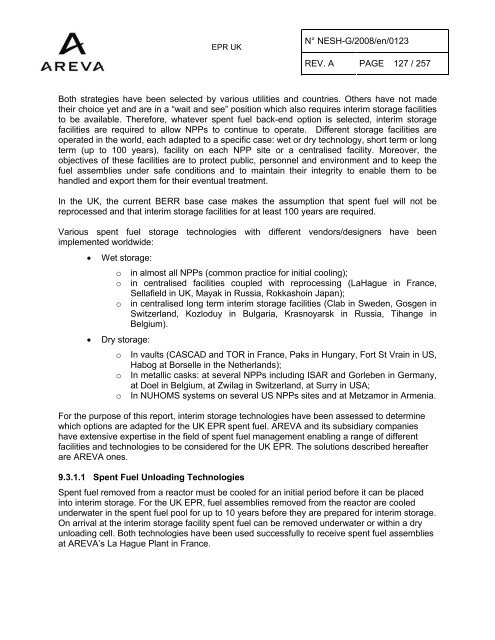Solid Radioactive Waste Strategy Report.pdf - UK EPR
Solid Radioactive Waste Strategy Report.pdf - UK EPR
Solid Radioactive Waste Strategy Report.pdf - UK EPR
Create successful ePaper yourself
Turn your PDF publications into a flip-book with our unique Google optimized e-Paper software.
<strong>EPR</strong> <strong>UK</strong><br />
N° NESH-G/2008/en/0123<br />
REV. A PAGE 127 / 257<br />
Both strategies have been selected by various utilities and countries. Others have not made<br />
their choice yet and are in a “wait and see” position which also requires interim storage facilities<br />
to be available. Therefore, whatever spent fuel back-end option is selected, interim storage<br />
facilities are required to allow NPPs to continue to operate. Different storage facilities are<br />
operated in the world, each adapted to a specific case: wet or dry technology, short term or long<br />
term (up to 100 years), facility on each NPP site or a centralised facility. Moreover, the<br />
objectives of these facilities are to protect public, personnel and environment and to keep the<br />
fuel assemblies under safe conditions and to maintain their integrity to enable them to be<br />
handled and export them for their eventual treatment.<br />
In the <strong>UK</strong>, the current BERR base case makes the assumption that spent fuel will not be<br />
reprocessed and that interim storage facilities for at least 100 years are required.<br />
Various spent fuel storage technologies with different vendors/designers have been<br />
implemented worldwide:<br />
· Wet storage:<br />
o<br />
o<br />
o<br />
· Dry storage:<br />
o<br />
o<br />
o<br />
in almost all NPPs (common practice for initial cooling);<br />
in centralised facilities coupled with reprocessing (LaHague in France,<br />
Sellafield in <strong>UK</strong>, Mayak in Russia, Rokkashoin Japan);<br />
in centralised long term interim storage facilities (Clab in Sweden, Gosgen in<br />
Switzerland, Kozloduy in Bulgaria, Krasnoyarsk in Russia, Tihange in<br />
Belgium).<br />
In vaults (CASCAD and TOR in France, Paks in Hungary, Fort St Vrain in US,<br />
Habog at Borselle in the Netherlands);<br />
In metallic casks: at several NPPs including ISAR and Gorleben in Germany,<br />
at Doel in Belgium, at Zwilag in Switzerland, at Surry in USA;<br />
In NUHOMS systems on several US NPPs sites and at Metzamor in Armenia.<br />
For the purpose of this report, interim storage technologies have been assessed to determine<br />
which options are adapted for the <strong>UK</strong> <strong>EPR</strong> spent fuel. AREVA and its subsidiary companies<br />
have extensive expertise in the field of spent fuel management enabling a range of different<br />
facilities and technologies to be considered for the <strong>UK</strong> <strong>EPR</strong>. The solutions described hereafter<br />
are AREVA ones.<br />
9.3.1.1 Spent Fuel Unloading Technologies<br />
Spent fuel removed from a reactor must be cooled for an initial period before it can be placed<br />
into interim storage. For the <strong>UK</strong> <strong>EPR</strong>, fuel assemblies removed from the reactor are cooled<br />
underwater in the spent fuel pool for up to 10 years before they are prepared for interim storage.<br />
On arrival at the interim storage facility spent fuel can be removed underwater or within a dry<br />
unloading cell. Both technologies have been used successfully to receive spent fuel assemblies<br />
at AREVA’s La Hague Plant in France.

















